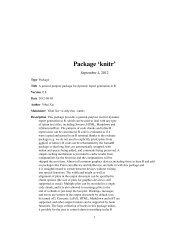22 drawOpenKeyof this option is to test whether there is a shift in the diurnal profile when GMT and BST hoursare compared. This option is particularly useful with the timeVariation function. For example,close to the source of road vehicle emissions, ‘rush-hour’ will tend to occur at the same local timethroughout the year e.g. 8 am and 5 pm. Therefore, comparing GMT hours with BST hours willtend to show similar diurnal patterns (at least in the timing of the peaks, if not magnitude) whenexpressed in local time. By contrast a variable such as wind speed or temperature should show aclear shift when expressed in local time for BST vs. GMT. In essence, this option when used withtimeVariation may help determine whether the variation in a pollutant is driven by man-madeemissions or natural processes."wd" splits the data by 8 wind sectors and requires a column wd: "NE", "E", "SE", "S", "SW", "W","NW", "N"."ws" splits the data by 8 quantiles of wind speed and requires a column ws."site" splits the data by site and therefore requires a column site.ValueReturns a data frame with a column cond that is defined by type.Author(s)David Carslaw (cutData) and Karl Ropkins (cutDaylight)Examples## split data by day of the weekmydata
drawOpenKey 23ArgumentskeydrawList defining the scale key structure to be produced. Most options are identicalto original draw.colorkey function.Original draw.colorkey options:space location of the scale key ("left", "right", "top" or "bottom"). Defaults to"right".col vector of colours, used in scale key.at numeric vector specifying where the colors change. Must be of length 1 morethan the col vector.labels a character vector for labelling the at values, or more commonly, alist describing characteristics of the labels. This list may include componentslabels, at, cex, col, rot, font, fontface and fontfamily.tick.number approximate number of ticks.width width of the key.height height of key.Note: width and height refer to the key dimensions. height is the lengthof the key along the plot axis it is positioned against, and width is the lengthperpendicular to that.Additional options include:header a character vector of extra text to be added above the key, or a list describingsome characteristics of the header. This list may include componentsheader, the character vector of header labels, tweaks, a list of local controls,e.g. ’gap’ and ’balance’ for spacing relative to scale and footer, respectively,auto.text, TRUE/FALSE option to apply quickText, and slot, a numeric vectorsetting the size of the text boxes header text is placed in.footer as in header but for labels below the scale key.Notes: header and footer formatting can not be set locally, but instead arematched to those set in labels. drawOpenKey allows for up to six additionallabels (three above and three below scale key). Any additional text is ignored.tweak, auto.text, slot as in header and footer but sets all options uniformly.This also overwrites anything in header and/or footer.fit the fit method to be applied to the header, scale key and footer when placingthe scale key left or right of the plot. Options include: ’all’, ’soft’ and ’scale’.The default ’all’ fits header, key and footer into height range. The alternative’scale’ fits only the key within height. (This means that keys keep the sameproportions relative to the main plot regardless of positioning but that headerand footer may exceed plot dimensions if height and/or slots are too large.plot.style a character vector of key plotting style instructions: Options currentlyinclude: ’paddle’, ’ticks’ and ’border’. ’paddle’ applies the incrementalpaddle layout used by winRose. ’ticks’ places ticks between the labels scalekey. ’border’ places a border about the scale key. Any combination of thesemay be used but if none set, scale key defaults to c("ticks", "border") formost plotting operations or c("paddle") for windRose.Option to return the key object or plot it directly. The default, FALSE, shouldalways be used within openair calls.
















